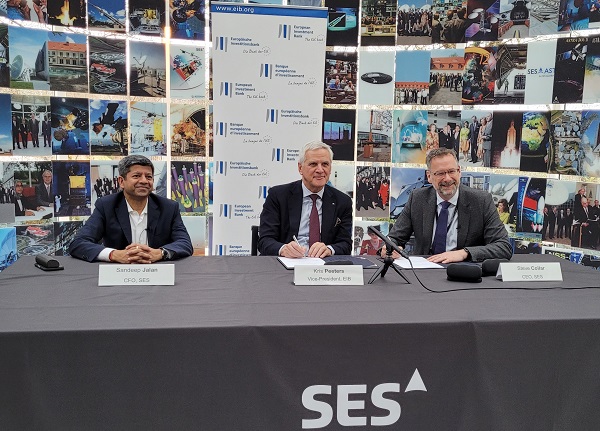 L-R: Sandeep Jalan, SES CFO; Kris Peeters, EIB Vice-President; Steve Collar, SES CEO;
Credit: Jazmin Campbell/Chronicle.lu
L-R: Sandeep Jalan, SES CFO; Kris Peeters, EIB Vice-President; Steve Collar, SES CEO;
Credit: Jazmin Campbell/Chronicle.lu
On Wednesday 11 January 2023, the management of SES and the European Investment Bank (EIB) formalised the conclusion of a €300 million financing agreement for ongoing SES projects; the signing ceremony took place, in the presence of members of the press, at SES's headquarters at Betzdorf Castle in Luxembourg.
This €300 million loan is the largest amount ever provided by the EIB to a Luxembourg-based company. The seven-year loan will back investments related to the design, procurement and launch of three previously announced satellites that will deliver advanced broadcast and broadband services across Western Europe, Africa and the Middle East.
The EIB-backed project includes the procurement of three satellites from Thales Alenia Space to deliver video broadcasting and network services. These satellites will operate from SES' prime TV neighbourhood of 19.2 degrees East and 57 degrees East. Two of the three are next-generation, flexible and fully software-defined satellites that will enable service reconfiguration and instant in-orbit adjustment to SES customers' demands. Upon their launch in 2024, all three satellites will be operated from SES' headquarters in Luxembourg.
Speaking at the signing ceremony on Wednesday, Steve Collar, Chief Executive Officer at SES, recalled SES's mission to "do the extraordinary in space to deliver amazing experiences on earth." He said that SES welcomed this "unique occasion" and looked forward to witnessing the launch together with the EIB team in 2024.
EIB Vice-President Kris Peeters cited various reasons why the EIB welcomed this financing agreement: not only is it the largest EIB loan provided to a Luxembourg-based company, but it also marks "a new phase" in the longstanding relationship between SES and the EIB. Mr Peeters stressed the importance of investing in the space industry and shared the EIB's view that this particular project will "bring added value to society." He also highlighted the importance of ensuring a level playing field for European companies: "Space is a key driver of innovation in Europe and we are eager to support space entrepreneurship. The size of the loan [...] also demonstrates how strategically important the space sector is for the EIB and the European Union." The EIB Vice-President concluded by thanking the SES and EIB teams for all their work in making this financing agreement possible.
Sandeep Jalan, Chief Financial Officer at SES, stated that this was a "very important step" for SES and that the company was "proud and honoured" to have been selected for EIB's largest ever corporate loan in Luxembourg. He noted that the loan "diversifies SES's sources of financing on attractive financial terms." Mr Jalan also highlighted the flexible nature of the financing agreement, which will enable SES to "deliver on [its] commitment to broadcast high-quality content from [its] prime TV neighbourhood serving 118 million TV households across France, Germany and Western Europe." He assured that this was "just the beginning" of SES's partnership with the EIB, with many more "exciting" projects in the pipeline.
As a reminder, the three satellites in question are part of SES's previously announced CAPEX programme. This EIB financing of €300 million is slightly under half of the overall costs of the entire programme for these three satellites. In terms of other financing, Sandeep Jalan recalled that the space industry is a very "capital intense business", although SES has a "large pool of finance." He reiterated to Chronicle.lu that the partnership with the EIB is a long-term one and that SES has a "stream of projects" yet to come.
Also in response to a question from Chronicle.lu, Steve Collar acknowledged that there was still a lot of work to do before the launch in 2024, with the team in Betzdorf set to be "more engaged" closer to the launch, in terms of operations and delivering services; currently, there are teams deployed in France working on the project. He recalled that the more traditional broadcasting satellite would be the first to launch, followed by a second fully digital satellite, thus representing the "best of both worlds".








